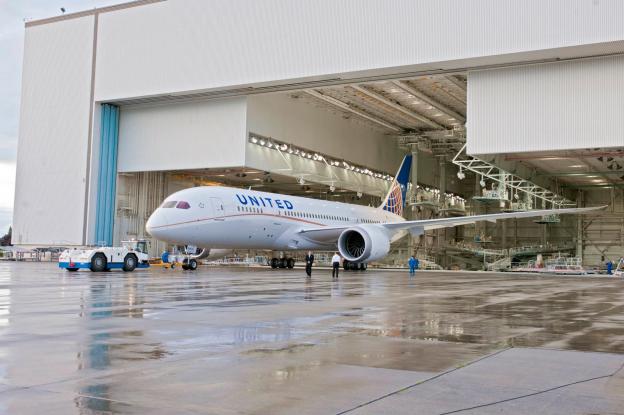 United Airlines showed off the first of its new Dreamliner fleet on Tuesday, rolling the plane out of a hangar at Boeing’s Everett, Washington facility.
United Airlines showed off the first of its new Dreamliner fleet on Tuesday, rolling the plane out of a hangar at Boeing’s Everett, Washington facility.
United will be the first US-based airline to fly the new-generation Boeing-made plane, with take-off loosely scheduled for later this year.
The passenger plane has been highly praised for its revolutionary design and technical innovations, with airlines around the world having placed just over 850 orders to date.
United posted pictures of its new aircraft – which features a nose-to-tail gold stripe along each side – on its Facebook page, with many visitors to the site responding with mostly positive messages.
Bruce Gustin was certainly impressed. “Wow! I would have given a bunch of my miles for an invite to this rollout! I cannot wait to board this aircraft!” he wrote with obvious glee.
Maggie Lamorte, on the other hand, seemed a little less certain. “Looks good….but how much is it going to cost to experience the dream….” she asked.
Jeannette Longeuay Ziegler, however, was thinking in more practical terms. “I hope you put more legroom in the coach seats because your planes have the worst coach seats in the business,” she wrote.

The fuel-efficient Dreamliner differs from the majority of passenger jets in that its frame is constructed not with aluminum but instead with ultra-light but extremely strong carbon fiber.
The added strength has allowed for 65 percent bigger windows, giving fliers a better view of the world when they’re 38,000 feet up. The windows also utilize electric dimmers to block out the light instead of pull-down shades.
Overhead baggage compartments have also been designed to offer more space, which should mean less trouble in finding somewhere to throw your hand luggage if you’re late to your seat when you board.
The Dreamliner completed its first commercial flight in October last year, flying from Japan to Hong Kong for All Nippon Airways (ANA).
The Japanese airline had to wait three years longer than expected for the delivery of its new 787 aircraft, with design and production issues causing the delay. Hopefully United Airlines won’t have to wait that long for the delivery of the rest of its order, which comprises a total of 50 Dreamliners. It’s not yet known which routes the new planes will fly.


